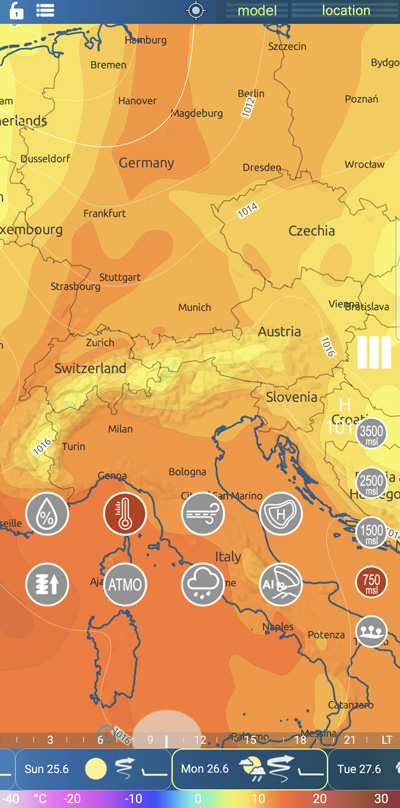Now also free widgets
How to do it
Select the main map icon for temperature.
A color map is displayed in the range -60°..60°C
(Units can be set in "settings".)
On the right side, you can choose a map for a specific height.

How does the temperature of the atmosphere and surface of the earth affect thermal flying?
The temperature of the atmosphere and the Earth's surface plays a crucial role in influencing thermal soaring and the glide ratio, known as paraglide. Here's how temperature affects these aspects:
Thermal Updrafts: Temperature differences between the ground and the surrounding air create thermal updrafts, which are rising columns of warm air. During the day, the sun heats the Earth's surface, causing the air near the surface to warm up. This warm air becomes less dense and starts to rise, creating thermal updrafts that glider pilots utilize for gaining altitude. The intensity and availability of thermal updrafts depend on the temperature gradient between the ground and the surrounding air.
Air Density: Temperature also affects air density. Warmer air is less dense than colder air. Lower air density reduces the glider's lift, making it more challenging to sustain flight. On hot days, when the air temperature is high, the density of the air decreases, and gliders may experience reduced lift. Pilots need to consider these variations in air density when planning their flights and optimizing their glide ratios.
Thermal Activity: The temperature of the atmosphere influences the generation and strength of thermal activity. Warmer air can create more vigorous and widespread thermals, providing glider pilots with better opportunities for climbing and extending their flights. Cooler air temperatures may result in weaker and more localized thermals, requiring pilots to search for suitable lift sources more carefully.
In summary, the temperature of the atmosphere and the Earth's surface directly impact thermal soaring and the glide ratio in terms of the availability and strength of thermal updrafts and the density of the air. Pilots must assess and adapt to these temperature variations to optimize their flights and maximize their glide performance.
Atmospheric temperature
Atmospheric temperature refers to the measure of the average kinetic energy of the molecules in the Earth's atmosphere. It determines how hot or cold the air is at a specific location and time.
The formation of atmospheric temperature is influenced by several factors, including the Sun's radiation, Earth's surface, and atmospheric composition. Here's a brief explanation of these processes:
Solar Radiation: The Sun emits electromagnetic radiation, including visible light and ultraviolet (UV) radiation. When the Sun's rays reach the Earth's atmosphere, they interact with gases and particles. The absorption of solar radiation by the atmosphere and Earth's surface leads to the heating of the air.
Conduction and Convection: The transfer of heat occurs through conduction and convection processes. Conduction refers to the direct transfer of heat between objects or surfaces in physical contact. Convection involves the transfer of heat through the movement of air or fluids. As the Earth's surface gets heated, it warms the surrounding air through conduction, and then convection currents distribute the heat vertically in the atmosphere.
Radiative Balance: The atmosphere plays a crucial role in maintaining the Earth's energy balance. It absorbs a portion of the Sun's incoming radiation and emits thermal radiation back into space. This radiative balance helps regulate the temperature of the atmosphere.
Atmospheric Layers: The Earth's atmosphere is divided into different layers, including the troposphere, stratosphere, mesosphere, thermosphere, and exosphere. Each layer has its unique temperature profile, influenced by factors such as solar radiation absorption, ozone concentration, and altitude.
The atmospheric temperature varies with location, time of day, and season. It is commonly measured using instruments like thermometers, weather balloons, and satellites. Understanding the temperature patterns and changes in the atmosphere is crucial for weather forecasting, climate studies, and various other scientific disciplines.
